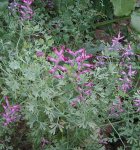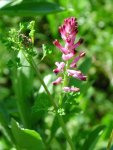Medicinal fumar - fumaria officinalis l.
Family Lymyanka - Fumariaceae
Botanical characteristics. Annual herbaceous plant. Stem branched, creeping, up to 10-15 cm tall. From wax plaque the plant looks greyish-green. Leaves are finely divided. Small irregular flowers, purple-pink, collected in a brush. Fruit is a single-seeded nutlet. Blooms all summer, fructifies until late autumn.
Spread. It grows in the European part of Russia, in Siberia, in Central Asia and the Far East. It occurs on fertile soils: in kitchen gardens, in gardens, in fields, wastelands.
Used parts of the plant. The medicinal raw material is the whole plant. It is pulled out with a root during flowering and dried in dryers at a temperature of 50 ° C.
Chemical composition. The plant contains organic acids: fumaric, succinic, glycolic, lactic, malic, citric; Alkaloids: sanguinarine, scooletin, protopin, fumaritin, cryptopine; Phenocarboxylic acids: coffee, chlorogenic; Tannins, flavonoids; Higher aliphatic alcohols: ceric; Vitamins, resins, microelements.
Application. The plant was officially planted in France, Brazil, included in the 1st - 3rd editions of the domestic pharmacopoeia.
In folk medicine, preparations of smokies in the form of broths and infusions were used and used for internal bleeding of various etiologies, gastritis with low acidity, fermenting and putrefactive processes in the intestines, constipation, hepatitis, cholelithiasis and renal stone diseases, bronchitis and pulmonary tuberculosis, hydrocephalus, diuretic , With malaria, hysterical conditions. Fresh juice - in the treatment of various skin diseases - eczema, scabies, lichens, rashes, acne. Concentrated infusions from the aerial part of the plant are used for compresses, lotions and baths for dermatomycosis, abscesses and other chronic inflammatory skin processes. Seeds - with impotence.
In the experiment, cigarette preparations have antiarrhythmic properties; The amount of alkaloids has an anti-inflammatory effect.
In Indian medicine, the smell is used as a choleretic, expectorant, diuretic, with jaundice, hemorrhoids, bleeding, intestinal atony, skin diseases.
Preparation
- For infusion take 6 g of the aboveground part of the plant, pour 200 ml of boiling water, insist on a boiling water bath for 15 minutes, cool 45 minutes, filter, bring to the desired volume by squeezing the residue. Take 2 tbsp. Spoon 3-4 times a day after meals. This same infusion can also be used for external use (for douching).
- For the treatment of skin diseases for external use, a more concentrated infusion is prepared, increasing the dose 2-3 times or evaporating cooked half.
- Tincture is made from grass. To do this, fill a half-liter bottle with a sliced fume and fill it up with alcohol. Insist 5-7 days. Use 30 minutes before meals and externally with skin diseases.
- To prepare the ointment, 1 tablespoon of dried and powdered herbs are mixed with 50 g of Vaseline. Store in a cool place.
- For broth take 3 g of seeds, pour 200 ml of boiling water, insist on a boiling water bath for 30 minutes, filter. Take should be 2 tbsp. Spoon 3-4 times a day after meals.
Contraindications. In the literature there is evidence of the virulence of the plant, so internal use requires caution. Attention! Do not exceed the dosage and technology of making preparations at home, keep it separate from other plants, hide ready-made preparations from children.





Comments
Commenting on, remember that the content and tone of your message can hurt the feelings of real people, show respect and tolerance to your interlocutors even if you do not share their opinion, your behavior in the conditions of freedom of expression and anonymity provided by the Internet, changes Not only virtual, but also the real world. All comments are hidden from the index, spam is controlled.